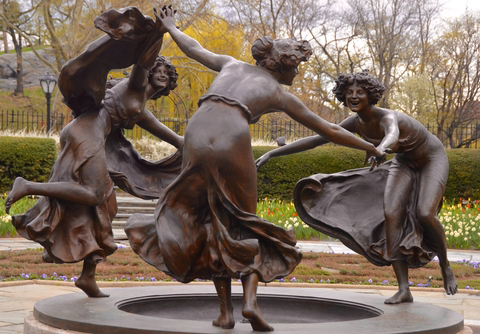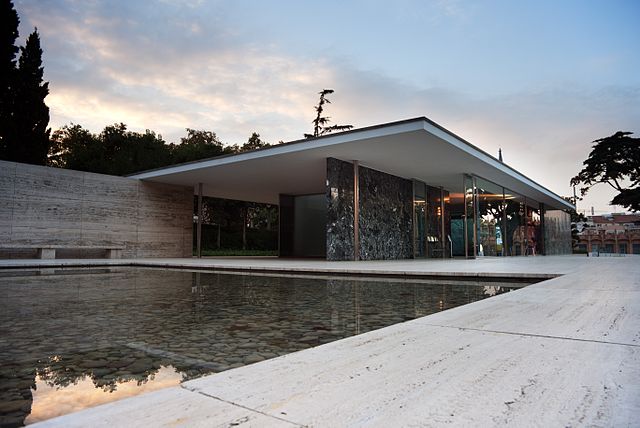sculpture
I've been to New York often through the years, mostly on business trips that have only rarely afforded me opportunities to get out and take in the sights. But on one occasion many years ago, I managed to shake out several extra days and spent my time experiencing as much of Manhattan as I could.
I ranged from Battery Park on the island's southernmost tip of the island up to The Cloisters on its northern reaches and managed to spend a whole, glorious early-fall day in Central Park. It was there, near the upper edge of Frederick Law Olmstead's masterpiece of urban space-making, that I came across a marvelous little fountain that's well worth a few extra steps the next time your travels take you to the Big Apple.
The fountain I'm referring to wasn't here originally. For many years, it had graced the Yonkers, N.Y., estate of Samuel Untermyer, who passed away in 1940. He was a New York lawyer and prominent civic leader, and when his children donated the fountain to the park, the monuments committee placed it by 1947 in an estimable space in the Conservatory Garden.
This is the original fountain. To see it, you need to travel all the way to Mecklenburg, Germany.
The fountain's sculpture, "Three Dancing Maidens" by the German artist Walter Schott, isn't exactly "original" either: It's one of a set of replicas cast in Berlin at some point after the artist finished his work around 1910. Schott was a favorite of Kaiser Wilhelm and spent a lot of time doing monumental portrait busts and conventionally grand statues of historical figures, but he was capable of working with far greater subtlety and expressiveness - these fair and flowing maidens being a case in point.
The fountain freezes from time to time, as seen in this photograph taken in 2008. The frozen drapery adds a special touch to the composition.
I haven't seen the Untermyer Fountain in more than 30 years, but it came quickly back to mind when I saw it among a photo survey of New York fountains frozen by wintertime cold snaps. As you may recall, I'm an avid fan of frozen fountains and waterfalls; I've always supposed it has something to do with the fact that my family escaped the Frost Belt when I was very young -- but I still have early (and happy) memories of icicles draping everything in sight.
You don't have to withstand frosty weather to appreciate the Untermyer Fountain: I saw it on a warm October day, and I have to say there's no better place to be than New York (and Central Park!) at that time of year.
By Jim McCloskey
I've been to New York many times through the years, mostly on business trips that have only rarely afforded me opportunities to get out and about and take in the sights. But on one occasion many years ago, I managed to shake out several extra days and spent my time experiencing as much of Manhattan as I could.
I covered the run from the southernmost tip of the island up to The Cloisters on its northern reaches and managed to spend the full length of one glorious early-fall day in Central Park. It was there, near the top edge of Frederick Law Olmstead's masterpiece of urban space-making, that I came across a marvelous little fountain that's well worth a few extra steps the next time your travels take you to the Big Apple.
The fountain I'm referring to wasn't here originally. For many years, it had graced the Yonkers, N.Y., estate of Samuel Untermyer, who passed away in 1940. He was a New York lawyer and prominent civic leader, and when his children donated the fountain to the park, the monuments committee placed it by 1947 in an estimable space in the Conservatory Garden.
The fountain's sculpture, "Three Dancing Maidens" by the German artist Walter Schott, isn't exactly "original" either: It's one of a set of replicas cast in Berlin at some point after the artist finished his work around 1910. Schott was a favorite of Kaiser Wilhelm and spent a lot of time doing monumental portrait busts and conventionally grand statues of historical figures, but he was capable of working with far greater subtlety and expressiveness - these fair and flowing maidens being a case in point.
I haven't seen the Untermyer Fountain in more than 30 years, but it came quickly back to mind when I saw it among a photo survey of New York fountains frozen by wintertime cold snaps. As you may recall, I'm an avid fan of frozen fountains and waterfalls; I've always supposed it has something to do with the fact that my family escaped the Frost Belt when I was less than four years old and I have early (and happy) memories of icicles draping everything in sight.
But you don't have to withstand frosty weather to appreciate the Untermyer Fountain: I saw it on a warm October day, and I have to say there's no better place to be than New York (and Central Park!) at that time of year.
dry
© Victorianl | Dreamstime.com
Original fountain in Mecklenburg, Germany
Photo by Doris Antony, Berlin | Wikipedia
Frozen in 2008
Photo by Ralph Hockens, New York | Wikipedia
I live on the eastern-most fringe of the west side of Los Angeles, a neighborhood with an eclectic urban concoction of mixed nationalities and wide-ranging aesthetics - including a lack thereof. This hilly East Hollywood region has views of the downtown skyline and cars lined up regularly at four-way stop signs deployed in an effort to minimize the number of streetlights we must navigate to get from our homes to nearby Hollywood and Sunset Boulevards. In short, we are bursting at the seams with
Whenever I visit the area with any time to myself, I enjoy visiting the Art Institute of Chicago. Not only does the museum host a collection of artwork expansive enough to include Renaissance masters as well as cutting-edge Modernists, but it also has what may be the best museum shop I've ever encountered.
It'd be well worth the visit even if it didn't also have a wonderful waterfeature - the Fountain of the Great Lakes - on its west side.
I'm a sucker for fountains that make me think not only about how they work but also what they mean, and in this case the interpretation of the way the Great Lakes flow and interrelate leads to a few moments of interested reflection. It's not exactly literal, nor is it very complicated: It's just a charming an allegorical representation of five vast, interconnected lakes that contain more than a fifth of the world's fresh water.
I find it amusing that the fountain was controversial in its day. Some were upset because the imagery wasn't quite literal enough. Sure, if you're visualizing a map of the lakes it's a bit difficult to read the relationships of the five figures as a clear representation of the system, but that seems trivial.
And then there were objections because there's a certain amount of metallic breast on display; that, too, seems trivial in such a classical set of forms. (You have to wonder if, back in 1913, those same prudes ran around putting their version of sticky-notes all over any Rubens painting the museum might have been fortunate enough to acquire or borrow.)
Personally, my only complaint is that the fountain isn't where it was originally placed: In 1963, it was moved from a venue of much greater prominence to its current spot adjacent to what was then a new wing that had been added to the museum complex. The positioning isn't terrible, but I don't like the reflecting pool/fountain that now shoots jets of water up into the space: The big sculpture works better on its own!
As defects go, however, that's an easy one to ignore. So when you visit the Art Institute and its great museum shop, take a few extra steps and visit a wonderful fountain that tells a nice little story about the region and its heritage.
In my career, I've applied lots of fine finishes to swimming pools, spas, fountains and other types of waterfeatures. Most often we work with glass tile, but we also keep our hands in a variety of ceramic or porcelain tiles, various mosaics and, generally, what most would call classy, top-flight materials. No two projects are ever quite the same, but the procedures we follow are: In every case, we at Rock Solid Tile (Calabasas, Calif.) end up having to work through imperfections in the concrete shells left for us by builders and their concrete crews - and that's true even if they're experienced and have
I lived in Cleveland at a point when I was too young to remember a thing about the place: We moved there when I was ten months old and stayed for about a year. But I've always considered it as one of my several "home towns" and have been back there twice since we moved away in 1957, both times on business - and both times before I became involved with watershaping.
Just the same, as an art history enthusiast and fan of impressive sculpture, I had my breath taken away by "The Fountain of Eternal Life." Dedicated in 1964, it was designed and executed by Marshall Fredericks, a resident of Michigan but a 1930 graduate of the Cleveland School of Art. The fountain serves as an inspiring memorial to residents of the city who died in conflicts reaching all the way back to the Spanish-American War.
It wasn't that inclusive when I first saw it in 1978 and again a few years later: Originally, the bronze plates surrounding the rim of the fountain memorialized only casualties of World War II and the Korean War. This recognition has since been expanded on a couple of occasions to include all Clevelanders who've died in defense of their country in the span from 1899 to, so far, 2014.
The testimony of sacrifice as witnessed by the names is moving, but the sculptures within the fountain are quietly but utterly inspirational. The central figure, which rises high above the basin and stands on a representation of the earth engulfed in flames, signifies the spirit of mankind rising above the destruction of war and reaching hopefully for a new and enduring comprehension of the value of life. The four granite sculptures at the base represent the world's civilizations and express a general desire for a global future free of war.
I haven't been back to Cleveland in many years, but I know that, when and if I return, one of my first stops will involve revisiting this fountain.
It was meaningful and impressive enough when I first saw it, but the continued addition of names is a reminder that, for all of our aspirations, for all of our sacrifices as friends and relations of wars' casualties, we can't seem to realize Fredericks' idealistic dream.
It's a humbling space - a graceful, monumental sculpture and a gracious, inspirational reminder that we are all in this together.
To see a brief video of the fountain in action, click here. The narration is a bit, well, distracting, so turn the sound down and watch: The images are just fine.
Avalon Fountains (Malibu, CA) has published a digital catalog covering its line of nature-inspired fountains…



















